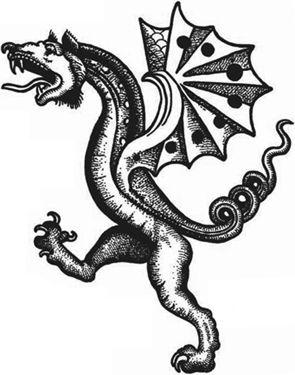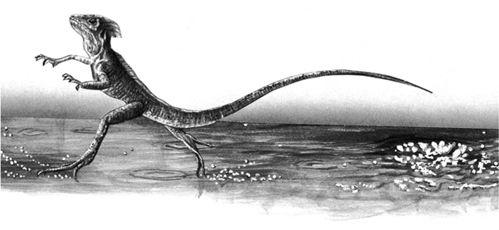The Sorcerer's Companion: A Guide to the Magical World of Harry Potter (14 page)
Read The Sorcerer's Companion: A Guide to the Magical World of Harry Potter Online
Authors: Allan Zola Kronzek,Elizabeth Kronzek


 he basilisk is one of our favorite monsters. Depending on who tells the tale, it is a venom-spitting serpent, a ferocious lizard, a towering
he basilisk is one of our favorite monsters. Depending on who tells the tale, it is a venom-spitting serpent, a ferocious lizard, a towering
dragon
, or an impossible hybrid sporting the head and wings of a rooster attached to the body of a
snake
. Like the enormous green serpent that Harry encounters in the Chamber of Secrets, the basilisk is always frightening and often deadly, having the power to kill its victims by its stare alone.

We first hear of this charming reptile from Pliny the Elder, the first-century Latin writer whose book
Natural History
reflects much of what ancient Romans believed about the natural world. According to Pliny, the basilisk is a small but lethal snake, no more than twelve inches long, and native to North Africa. Known as “king of the serpents” because of the crownlike markings on its head
(basiliskos
means “little king” in Greek) the basilisk advanced upon its prey with its body held upright, rather than wriggling across the ground like other snakes, and could set fire to bushes and break stones apart simply by breathing on them. The basilisk lived in the desert, not necessarily because it chose to, but because no matter where it lived, the land was eventually reduced to desert by the beast’s scorching breath. Its venom was so powerful, Pliny reported, that if a rider on horseback killed a basilisk with a spear, the venom would rise up through the spear, kill the rider, and then kill the horse as well.
If a snake can have an Achilles’ heel, the basilisk had two: It could not tolerate the scent of a weasel or the sound of a rooster crowing. To slay a basilisk by weasel it was necessary to first lure the serpent into a weasel’s den and then block the entrances and exits, whereupon the serpent would succumb to the weasely fumes. Death by rooster was far easier as, according to the Roman writer Claudius Aelian, the mere sound of a cock crowing would cause the basilisk to go into convulsions and die (it was to protect the basilisk in the Chamber of Secrets from just such a fate that Tom Riddle arranged the demise of several roosters at Hogwarts). But perhaps the best defense of all was to hold a mirror up to the basilisk, turning its own fatal gaze against it and causing it to die of fright.
Like many an imaginary creature, the basilisk was probably based on a real animal—in this case the Egyptian cobra, which has a lethal venom, moves with its head held upright, and has markings on its head resembling a crown. As was common in antiquity, however, writers who described the customs and creatures of foreign lands often did so without ever having left home. Rather, they based their reports on the secondhand accounts of foreign travelers who no doubt embellished their tales to make them more interesting. As reports were told and retold, the lore of the basilisk grew.
By the Middle Ages popular books of mythical beasts had begun to describe the basilisk as a bizarre monster having the body of a snake (it was
all
snake in Greek and Roman traditions) and the head, wings, and sometimes feet of a rooster. This version of the creature, which legend had it could now be found in England as well as in Africa, was known as a cockatrice as well as a basilisk. The unlikely combination of snake and chicken apparently arose from stories concerning its birth, which told of the basilisk hatching from a rooster’s egg that had been laid in a hillside and incubated by a
toad
. It is this image of the basilisk that was widely known and depicted in medieval art and heraldry, sometimes with a body covered in feathers, sometimes in scales.
The basilisk of the Chamber of Secrets, however, is clearly of the older type, strictly a serpent and a huge one, too, as befits the heir of Slytherin.

The modern namesake of the mythical basilisk is an amazing tropical lizard found in the rain forests of Central and South America. A member of the iguana family, it lives in trees and among rocks and is able to sprint across the surface of water, standing on its hind legs, holding its body almost upright. It is an excellent swimmer and climber and dines on insects, spiders, and other small animals. Because it can apparently walk on water, it is sometimes called the Jesus lizard.
(
photo credit 5.2
)

 aving a hairball is
aving a hairball is
rarely
considered lucky. But when Ron Weasley drinks poisoned mead intended for Dumbledore, it’s certainly lucky that Harry has easy access to a bezoar—a magical sort of hairball that saves Ron’s life. As every first-year potions student learns, a bezoar is a stonelike mass taken from the stomach of a goat that acts as an antidote to most poisons. This real-life object is usually made of hair, plant fiber, or similar indigestible matter that stays in the gut of an animal and forms a hard ball or “stone.” For centuries, bezoars were believed to have miraculous medicinal properties.




